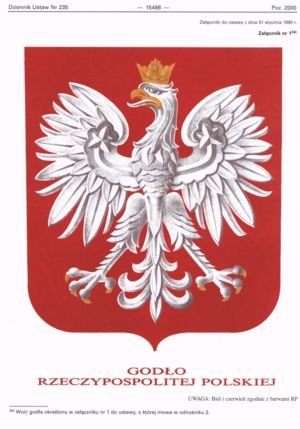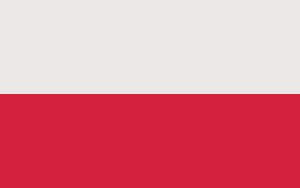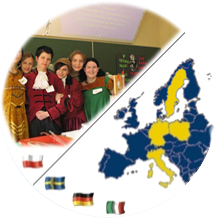The Republic of Poland is identified by a great many symbols, but three of them are of greatest importance and are commonly recognized on the international arena. They include:
- The emblem of the Republic of Poland (White Eagle)
- The Polish national flag (national colours are white and red)
- The Polish national anthem (Dąbrowski’s Mazurka)
The Emblem of Poland

The coins issued by the first king of Poland, Bolesław Chrobry (died 1025), are known to have born the image of an eagle which ever since has undergone a good number of transfigurations. The emblem of the Polish-Lithuanian Commonwealth also depicted an eagle. At the time of the rule of the last king of Poland, Stanisław August Poniatowski (died 1798), the eagle was holding a sceptre. The post-war communist government deprived the eagle of the crown. After democratic rule was reinstated in 1989, the eagle got the crown back and today it looks as pictured above in keeping with the provisions included in the Journal of Laws. The eagle is shown in the ready-to-fight position. One has to add that the Polish Army possesses its own versions of the emblem, each one characteristic of the Land Forces, Navy, and the Air Force.
The Flag of Poland

Originally, the Polish national colour used to be scarlet, regarded as the most noble of all colours. It was used as the symbol of dignity and affluence. Owing to the price of the dye necessary for obtaining the colour there were very few people who could afford it so the colour was worn by the richest gentry and state dignitaries.
White and red were first declared Polish national colours on the 3rd of May 1792. During the celebrations of the first anniversary of the approval of the first Polish constitution women were wearing white dresses and red sashes. Men were wearing white and red sashes. The colours referred to the emblem of the Polish Kingdom – white eagle shown against a red coat of arms.
According to the 1980 Emblem, National Colours and National Anthem Act as well as the State Seals Act, the Polish flag is a rectangular, red and white piece of fabric hoisted up a flagpole. According to the Article 6 Section 2 of the Act, a version with the emblem of Poland placed in the middle of the white stripe is also regarded as the flag of Poland. When the flag is hanging vertically the red stripe ought to be on the right-hand side and the white stripe ought to be placed on the left-hand side.
The National Anthem of Poland
Since February 26, 1927 Dąbrowski’s Mazurka, Polish patrotic song, has been an official anthem of the Republic of Poland. After the song originated, it was enthusiastically welcomed by the Polish Legions of the Napoleonic wars under command of general Dąbrowski. At the beginning of 1798 the song was also known across Polish territory occupied by Russians, Germans and Austrians. It was sung during November (1830) and January (1863) Uprisings. It was also known in the immigration circles in the 19th century and sung during 1905 revolution as well as World War I and II. The Mazurka was translated into 17 languages by the poets standing by the Polish people fighting for their independence. Its text is known in such languages as German, French, English, Russian, Hungarian, Croatian, Macedonian, Serbian, Lithuanian and Slovak.
| Jeszcze Polska nie zginęła, Kiedy my żyjemy. Co nam obca przemoc wzięła, Szablą odbierzemy. Marsz, marsz, Dąbrowski, Z ziemi włoskiej do Polski, Za twoim przewodem Złączym się z narodem. Przejdziem Wisłę, przejdziem Wartę, Będziem Polakami, Dał nam przykład Bonaparte, Jak zwyciężać mamy. Marsz, marsz, Dąbrowski... Jak Czarniecki do Poznania Po szwedzkim zaborze, Dla ojczyzny ratowania Wrócim się przez morze. Marsz, marsz, Dąbrowski... Już tam ojciec do swej Basi mówi zapłakany: "Słuchaj jeno, pono nasi Biją w tarabany." Marsz, marsz, Dąbrowski... |
Poland has not yet perished, So long as we live. What foreign violence has taken from us, We will reclaim, sabre in hand. March, march, Dąbrowski, From the land of Italy to Poland, Behind your leadership We will unite as a people. We'll cross the Vistula, we'll cross the Warta River, And we shall be Poles, Bonaparte has shown us How to be victorious. March, march, Dąbrowski... As Czarniecki to Poznań After the Swedish occupation, To save our country We will return across the sea. March, march, Dąbrowski... A father was saying to his (daughter) Basia With tears in his eyes: "Listen, now, are those our boys Beating the drums." March, march, Dąbrowski... |
The original lyrics to Dąbrowski's Mazurek, as written by Wybicki, included two additional stanzas (absent from the official lyrics to the Polish national anthem):
| Niemiec, Moskal nie osiędzie, Gdy jąwszy pałasza Hasłem wszystkich zgoda będzie I Ojczyzna nasza Marsz, marsz, Dąbrowski... Na to wszystkich jedne głosy Dosyć tej niewoli! Mamy Racławickie kosy Kościuszkę, Bóg pozwoli. Marsz, marsz, Dąbrowski... |
German, Muscovite won't withstand When, having taken backsword in hand Unity will become the watchword of all and our Fatherland will be ours. March, march, Dąbrowski... So let us proclaim in unison: Enough of this bondage! We have scythes from Racławice And Kościuszko, God willing. March, march, Dąbrowski... |



